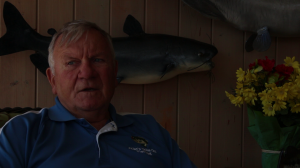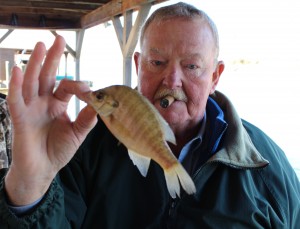Fishing has changed significantly in Lake Norman in the fifty years since the dam was built, due to a number of factors. Increased development around the lake, stricter environmental regulations, species introduction by the North Carolina Wildlife Resources Commission and local fishermen, and the resulting interactions have all played a role in crafting these changes.
Recreational sportfishing has supplanted subsistence and commercial fishing as the main mode of fishing on the lake. Primary target fish now include spotted bass, blue catfish, and crappie. Bodie bass are also predicted to become a major target fish in the coming decade. However, these fish have not always been the dominant species. The majority of these fish have supplanted a previously dominant gamefish in their respective ecological niches.
Introduced by the North Carolina Wildlife Resources Commission (NCWRC) in 1969, striped bass were once the dominant open water fish in Lake Norman. Although striped bass cannot successfully reproduce in freshwater reservoirs, they otherwise fare very well, and they became the most popular game fish on Lake Norman soon after their introduction. After nearly a decade of fish kills, however, the Lake Norman striped bass fishery declined precipitously, and the NCWRC made the decision to discontinue their stocking program in 2012. Bodie bass (striped bass/white bass hybrids) were illegally stocked in the lake by local fishing clubs to replace these lost striped bass, beginning around 2008. Though Bodie bass are smaller and also cannot successfully reproduce, they fare much better during the summer months than striped bass do. Because of their successful introduction by the fishing clubs and public pressure from those clubs and other local fishermen, the NCWRC began to stock Bodie bass in 2013.
Historically, largemouth bass are another very popular game fish. Though they were stocked briefly (in 1978), they are native to the Catawba River and have been in the lake since the river was dammed. They can still be found in Lake Norman, but spotted bass were illegally introduced to the lake in the early 2000’s and have since overtaken largemouth bass the dominant black bass in the lake. Largemouth bass fishermen didn’t really mind this change, though, as spotted bass look and behave very similarly to largemouths (although they are a bit smaller).
The primary catfish in the Catawba River was once the channel catfish. The NCWRC introduced blue catfish, native to tributaries of the Mississippi River, into Lake Norman in 1966. Although they were only stocked for one year, they were well suited to life in Lake Norman and are now a prominent target fish. Blue catfish are likely the largest fish in the lake: until recently, the state record blue catfish was an 85 lb fish pulled from the depths of Lake Norman, and the world record is currently a 143 lb fish that was caught in Kerr Lake, which straddles the North Carolina/Virginia border. Flathead catfish have also recently taken hold in the lake, which some anglers attribute to development along the shoreline (specifically rip rap bulkheads) that have provided more habitat for crayfish. Flathead catfish can grow nearly as large as blue catfish–the state record is a 78 lb fish that was caught in the Cape Fear River
There have also been a couple of other notable changes in the species composition of Lake Norman. Gizzard shad were once the only true baitfish in Lake Norman, but blueback herring were illegally stocked in the lake by the striped bass clubs and now comprise a significant segment of the baitfish population. Herring and gizzard shad form the primary food supply for large fish on the lake, with shad being found mostly near the surface and herring mostly in deeper waters. Also, white perch were recently introduced into the lake and have largely exterminated white bass, a native fish, from the lake by eating their eggs.
In the following video, three prominent Lake Norman fishermen explain some of the changes they have seen in the lake, especially concerning the three biggest fisheries: striped bass, black bass, and catfish. With over a hundred years of fishing experience between them (and the vast majority of that on Lake Norman) these fishermen are experts on the issue and have some interesting stories to tell.
Interviewee Biographies
Jake Bussolini is a former engineer and corporate executive who has written six books on fishing (including one about Lake Norman), as well as articles for various newspapers and magazines. He also lectures regularly at Gander Mountain in Mooresville and hosts fishing clinics for local children and their families.
Captain Gus Gustafson is a Lake Norman fishing guide with over fifty years of experience fishing in the area. Gus also writes columns for local newspapers and magazines, and lectures regularly at Gander Mountain in Mooresville. He is the owner of Lake Norman’s Fishing with Gus! guide service.
Sam “Rawhide” Newman is a former pest control professional who has been actively involved in Lake Norman striped bass management for decades. Rawhide advocates on behalf of striped bass clubs on Lake Norman for legislation to restore the health of striped bass fishery, and he also owns the unofficial lake record for striped bass at 34 lbs.
Photo Credits
Pictures used in the video (LNM 5058 & 5077) courtesy of Lake Norman Magazine.
Striped bass photo courtesy of Lake Mead NRA Public Affairs. Image shown under Public License without modification.
Largemouth bass photo courtesy of Joshua Mayer. Image shown under Public License without modification.




